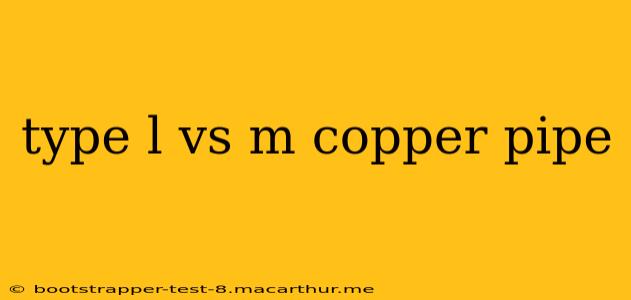Type L vs. Type M Copper Pipe: A Comprehensive Comparison
Choosing the right type of copper pipe for your plumbing project is crucial for ensuring longevity, safety, and efficiency. Two of the most common types are Type L and Type M copper pipes, each possessing distinct characteristics that make them suitable for different applications. This guide will delve into the key differences between Type L and Type M copper pipes, helping you make an informed decision.
What are Type L and Type M Copper Pipes?
Both Type L and Type M copper pipes are made from annealed (soft) copper, offering excellent corrosion resistance and durability. The primary difference lies in their wall thickness: Type L has a thicker wall than Type M. This difference in wall thickness dictates their pressure ratings and suitability for various applications.
Key Differences: Type L vs. Type M
| Feature | Type L Copper Pipe | Type M Copper Pipe |
|---|---|---|
| Wall Thickness | Thicker | Thinner |
| Pressure Rating | Higher (typically used for higher-pressure applications) | Lower (typically used for lower-pressure applications) |
| Flexibility | Less flexible | More flexible |
| Cost | More expensive | Less expensive |
| Applications | Underground lines, high-pressure systems | Interior plumbing, less demanding applications |
What is the Pressure Rating of Type L and Type M Copper Pipes?
The pressure rating isn't a fixed number but depends on the pipe's diameter and the specific standards used (e.g., ASTM B88). Generally speaking, Type L copper pipe has a significantly higher working pressure rating compared to Type M. This means it can withstand greater water pressure without failure.
Which Type of Copper Pipe is More Durable?
Type L's thicker walls make it more resistant to dents, punctures, and damage from external forces. This enhanced durability makes it ideal for applications where the pipe might be subjected to more stress, such as underground installations. However, Type M's flexibility can be an advantage in certain situations, allowing for easier installation in tight spaces.
What are the Typical Applications for Type L and Type M Copper Pipes?
-
Type L: Often used for underground water lines, main water supply lines, high-pressure systems, and applications where durability and high pressure resistance are critical.
-
Type M: Commonly used for interior plumbing systems, including hot and cold water lines within a building. Its thinner walls and increased flexibility make it easier to work with in confined spaces.
Which is Better: Type L or Type M Copper Pipe?
There's no universally "better" pipe—the optimal choice depends entirely on the specific application. For high-pressure applications or installations where durability is paramount, Type L is the preferred choice. For less demanding applications, such as interior plumbing in residential settings, Type M offers a cost-effective solution with sufficient durability for most situations.
What are the Different Types of Copper Pipe?
Besides Type L and Type M, there are other types of copper pipes, including Type DWV (drain, waste, and vent) and Type K, each designed for specific plumbing applications. Type K has an even thicker wall than Type L, making it suitable for very high-pressure applications.
Ultimately, consulting local plumbing codes and working with a qualified plumber will ensure the correct type of copper pipe is selected for your specific project, ensuring safety and compliance. Remember, proper installation is just as crucial as choosing the right pipe type.
